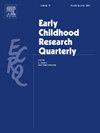Understanding inattention, hyperactivity/impulsivity, and peer rejection in preschool: The potential role of conduct problems and prosocial behavior
IF 3.1
1区 教育学
Q1 EDUCATION & EDUCATIONAL RESEARCH
引用次数: 0
Abstract
Peer relationships are imperative for healthy social and emotional development. In preschool, children are exposed to a new, structured environment, in which there is a sharp learning curve to adjust to unfamiliar expectations. Children with inattention (IA) and hyperactivity/impulsivity (H/I) may have limited social awareness and exhibit disruptive behaviors that lead to peer rejection. Beyond IA and H/I, additional factors may contribute to peer rejection. Conduct problems (e.g., defiance, aggression) and limited prosocial behavior (e.g., sharing, helping) are two social behaviors that are related to peer rejection and are typically observed in children with increased levels of IA and H/I. This study examined the degree to which conduct problems and prosocial behavior account for the link between IA, H/I, and peer rejection in a community sample of preschoolers. Data from 131 preschool children (91.6 % White, 45.8 % Female) who participated in a screening project were analyzed. Indirect effect pathways were examined using structural equation modeling (SEM) in MPlus. Results indicated that when conduct problems and prosocial behavior were included in each model, the direct effect of IA and H/I on peer rejection was no longer significant. Findings suggest that IA and H/I may not be the behaviors that are disrupting a preschooler’s social standing. Findings emphasize the influence preschoolers’ behaviors have on their social status, underscoring the relevance of early childhood when attempting to understand social developmental trajectories. Future longitudinal studies are needed to clarify temporal ordering and strengthen the basis for causal inference.
理解学龄前儿童注意力不集中、多动/冲动和同伴排斥:行为问题和亲社会行为的潜在作用
同伴关系对健康的社会和情感发展至关重要。在学龄前,孩子们暴露在一个新的、结构化的环境中,在这个环境中,有一个尖锐的学习曲线来适应不熟悉的期望。注意力不集中(IA)和多动/冲动(H/I)的儿童可能具有有限的社会意识,并表现出导致同伴排斥的破坏性行为。除了IA和H/I之外,其他因素也可能导致同伴排斥。行为问题(如反抗、攻击)和有限的亲社会行为(如分享、帮助)是两种与同伴排斥有关的社会行为,通常在IA和H/I水平升高的儿童中观察到。本研究以社区学龄前儿童为样本,考察了行为问题和亲社会行为在IA、H/I和同伴排斥之间的联系中的作用程度。对131名学龄前儿童(91.6%白人,45.8%女性)的数据进行分析。利用MPlus的结构方程模型(SEM)研究了间接效应途径。结果表明,当行为问题和亲社会行为被纳入每个模型时,IA和H/I对同伴拒绝的直接影响不再显著。研究结果表明,IA和H/I可能不是破坏学龄前儿童社会地位的行为。研究结果强调了学龄前儿童的行为对其社会地位的影响,强调了幼儿期在试图理解社会发展轨迹时的相关性。未来的纵向研究需要澄清时间顺序和加强因果推理的基础。
本文章由计算机程序翻译,如有差异,请以英文原文为准。
求助全文
约1分钟内获得全文
求助全文
来源期刊

Early Childhood Research Quarterly
Multiple-
CiteScore
7.00
自引率
8.10%
发文量
109
期刊介绍:
For over twenty years, Early Childhood Research Quarterly (ECRQ) has influenced the field of early childhood education and development through the publication of empirical research that meets the highest standards of scholarly and practical significance. ECRQ publishes predominantly empirical research (quantitative or qualitative methods) on issues of interest to early childhood development, theory, and educational practice (Birth through 8 years of age). The journal also occasionally publishes practitioner and/or policy perspectives, book reviews, and significant reviews of research. As an applied journal, we are interested in work that has social, policy, and educational relevance and implications and work that strengthens links between research and practice.
 求助内容:
求助内容: 应助结果提醒方式:
应助结果提醒方式:


